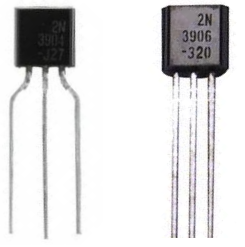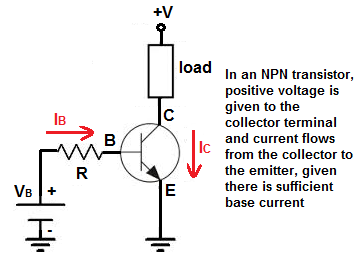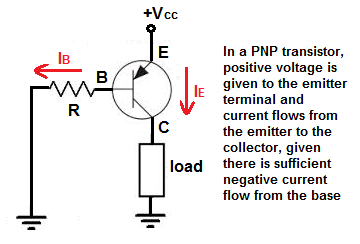Difference Between an NPN and a PNP Transistor

Before we talk about the differences between NPN and PNP transistors, we will first discuss what they are and their similarities.
Both NPN and PNP are bipolar junction transistors (BJTs). BJTs are current-controlled transistors that allow for current amplification.
A current at the base of the transistor allows for a much larger current across the emitter and collector leads. NPN and PNPs are exactly the same in their function, they provide amplification and/or switching capability.
So technically, they achieve and do the same exact thing.
How they differ is how power must be allocated to the terminal pins for them to provide this amplification or switching. Since they are internally constructed very differently, current and voltage must be allocated differently in order for them to work. An NPN transistor receives positive voltage to the collector terminal and positive voltage to the base terminal for proper operation. A PNP transistor receives positive voltage to the emitter terminal and a negative voltage at the base terminal (or rather a more negative or lower voltage than what is supplied at the emitter terminal).
Since voltage allocation is different, how current flow works to turn them on is different. An NPN transistor is powered on when a sufficient current is supplied to the base of the transistor. Therefore, the base of an NPN transistor must be connected to positive voltage for current to flow into the base. A PNP transistor is the opposite. In a PNP transistor, current flows out of the base (negative current to the base) by giving the base terminal a more negative (a lower) voltage than what is supplied to the emitter terminal. As long as the voltage at the base terminal is lower than at the emitter terminal in a PNP transistor, the correct biasing and negative current effect will be achieved.
So knowing this, with an NPN transistor, current needs to be sourced to the base of the transistor for operation. This means current needs to flow into the base. In a PNP transistor, current is sourced away or sinked from the base of the transistor to ground for operation. This means current needs to flow out of the base. So a simple approach of thinking about it is an NPN transistor requires positive current to the base, while a PNP requires negative current to the base (current must flow out from the base to ground).
Another concept differentiating NPN and PNP transistors is that since voltage is allocated differently, they have opposite current
flows at the output. In an NPN transistor, output current flows from the collector to the emitter. In a PNP transistor, output current flows from the
emitter to the collector.
Below we go over the concepts explained above in more depth, with diagrams, to better illustrate the differences between NPN and PNP transistors.
Voltage Allocation and Current Flow are Switched
Since PNP and NPN transistors are composed of different materials, how voltage is biased to them to produce current flow is different, and their current flow is opposite as well.
PNP transistors are made up of 2 layers of P material sandwiching a layer of N material, while NPN transistors are made up of 2 layers of N material sandwiching 1 layer of P material. Really opposites.
Therefore, to produce current flow in an NPN transistor, positive voltage is given to the collector terminal and current flows from the collector to the emitter. For a PNP transistor, positive voltage is given to the emitter terminal and current flows from the emitter to the collector.
This is summarized right below.
Voltage and Current Biasing
NPN Transistor

An NPN transistor receives positive voltage at the collector terminal. This positive voltage to the collector allows current to flow across from the collector to emitter, given that there is a sufficient base current to turn the transistor on.
PNP Transistor

A PNP transistor receives positive voltage at the emitter terminal. The positive voltage to the emitter allows current to flow
from the emitter to the collector, given that there is negative current to the base
(current flowing out of the base to ground).
How They Operate (Turn On and Off)
NPN Transistor
This is how a NPN transistor works:
When the voltage supplied to the base exceeds the threshold voltage of 0.7V, as you increase current to the base of a NPN transistor, the transistor conducts more and more current until it conducts fully from collector to emitter.
And as you decrease current to the base of a NPN transistor, the transistor conducts current across from collector to emitter less and less,
until the voltage
supplied to the base is under the threshold voltage amount of 0.7V, at which point the transistor no longer conducts across collector to emitter and shuts off.
PNP Transistor
A PNP transistor functions the total opposite way.
As current is sinked from the base (flows out from the base to ground), the transistor is on and conducts across to power on the output load.
So these are the main concepts of NPN vs PNP transistors.
If you would like to search for more articles on this site for any topic, see our
search engine.
You can search the whole website for any information you may need.
Related Resources
BJT vs FET (Transistors)
JFET vs MOSFET (Transistors)
Types of Transistors
Transistor Schematic Symbols
How to Test a Transistor
